12 of the Best Youth Football Offenses

When it is time to find volunteers for coaching a youth football team, there are normally not many hands raised. One month later, however, after you begin to coach your team, everyone and their brother is an expert on coaching youth football and the best youth football offense you should run. Here at FirstDown PlayBook, we understand that. Right out the gate, we want to assure you that you know more about your team than we do because we don’t know your team at all. Heck, you might be coaching an All Star team you hardly know.
What we do know is football. When you use FirstDown PlayBook, you’re looking at youth football plays drawn by NFL coaches who have not only coached at that level, but have also been involved with helping youth football coaches for over a decade now. We understand that there are many factors that go into developing a football offense for kids, which is exactly why we’ve made it as easy as possible for coaches to find the youth football formations that fits their team best using the FirstDown PlayBook™ Youth Football Play Library & Play Drawing Tool.
A Good Youth Football Coach Will Always Look At Player Safety First
There are some core things that we believe are essential. We believe that you should always be teaching sound fundamentals and technique when coaching youth football. After all, you are laying the foundation for how kids experience our game now and possibly later if they continue to play. This means that you will use drills to teach the fundamentals that make the game safer. There are several other reasons you want to teach sound youth football offensive principles.
June Is Youth Football Month Here At FirstDown PlayBook!
Number one is that when a football offense for kids is played with sound schemes and technique, it goes a long way towards making it safer for the young players. One thing all good youth football coaches have in common is they look at player safety first. Those parents are going to pull up to practice and entrust you with their kids. That is a huge responsibility. Make sure what you teach is sound football and safe football.
Teaching Sound Football Will Help Develop Your Young Players & Bring Success Too
The second reason sound offensive schemes should be taught is that it gives a youth football player a chance to develop. Not all of your players are going to continue playing in high school. However, what you don’t want is young players who have come through your system to arrive at the prep level with no football foundation. This means you too if you are coaching youth football defense.
The third reason is that your offense will be more successful. Yes, you are going to see a lot of crazy things out there on the internet. A lot of it has no business being taught to young football players. Teaching tried and proven sound football offense and defense is going to allow your players to have a positive experience. That may not always parlay into winning, but teaching sound football offense for kids will ultimately help your team be better.
Look At Your Roster Before Choosing Your Youth Football Offense
So, where should you start? The same place that any good football coach starts…with your players. If you have some idea about what your roster is going to look like, that can help you a lot. You may know what offenses your team CAN NOT run before you decide what they can run. A good place to start is at the quarterback position.
This is the one area where NFL football and youth football are very similar. It all starts with the quarterback. In the NFL it becomes who can take a game over with their arm. With your youth football offense, it will be who can operate the offense. You will need to find an assertive player on your team who can take the snap and begin the execution of a play.
Finding A Quarterback Is Going To Make Everyone’s Experience Better
Let’s face it, if you do not have that, there is no rest of the team. Your youth football quarterback will be limited in the passing game. The sooner you understand that, the better decisions you are going to make choosing your offense. Do not watch tv to get your football offense for kids. Just don’t.
After that, you will begin to sort your players out by size to some degree. Yes, your bigger players will play the line and smaller players will play backs and receivers. In fact, you may have weight limit rules about some of this. We do want to caution you on this, though. There are smaller scrappy players who do more than well in a three point stance. Your best running back may also be one of your bigger players.
Let’s Start Looking For the Best Youth Football Offense To Fit Your Team
After you have sat down and learned as much about your football team as you can, it is now time to choose a formation or two that fits your players. In this article, we cover 12 youth football formations that we would feel great about running with any youth football team. Please understand, do not try to run all of them or even many of them. As a bonus, we also take look at how you may be able to include an unbalanced line with your kids’ football offense too. Let’s look at some youth football formations.
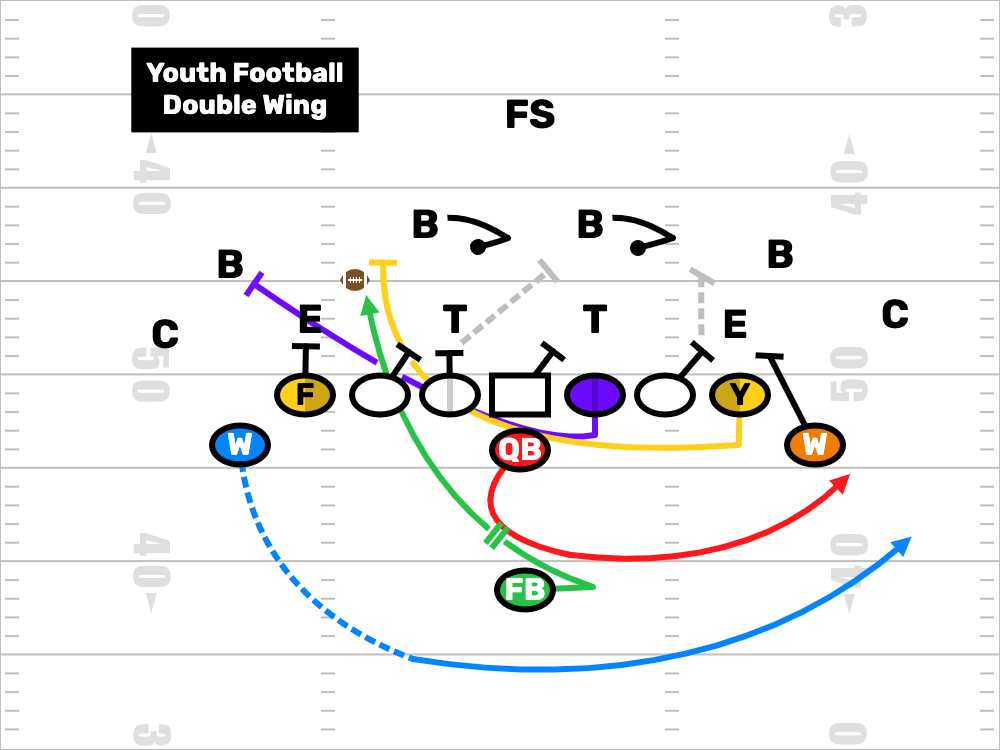
1. Double Wing Formation
The youth football Double Wing checks all of the boxes for the primary mission of any youth football coach. This mission should be to teach the fundamentals of the game. When we say fundamentals, we mean blocking and tackling.
The youth football Double Wing formation leaves plenty of options for a coach to generate a productive kids’ football offense, too. The Double Wing gives you balance and that forces your opponent to play honest to both sides. However, if you orbit motion one of your wings you are almost instantly in a 2 back offense.
This obviously gives you a perimeter attack to defend on either flank. A defense will be forced to spread out evenly and it also forces them to use their corners to tackle. This is not to mention the powerful option run game at your fingertips. Once you have them spread out, then you can motion to a 2 back set and work your inside game. Don’t forget to incorporate a counter run or two like you see on this play.

2. Power I Formation
The youth football Power I is your good old-fashioned I backfield with two fullbacks. Some defenses will key your fullback to find the ball on run plays. The Power I makes this a lot harder because you can choose which fullback is your lead blocker. You can also choose to have them both lead at the point of attack. There is an example of this in our play drawing.
You may just have three or four young players who are backfield types on your roster. The Power I gives you the ability to get all or most of them on the football field at the same time. It allows you to hand the ball off to any of the three backs and your quarterback can carry the ball too.
If you think the Power I is just about running the ball downhill, you have not looked close enough. The other thing this kids’ football offense gives you is a great counter game. Once you send two backs one direction and the third back another, you have a counter game. It does not take very much to create a strong side run game and a counter game off of it. Any time you have a counter game, you also have a good bootleg pass game as well.

3. Wing T Formation
When you say Wing T, you are automatically saying buck sweep too. There are youth football and high school football coaches who have never run anything but the Wing T. They are firmly committed to the thinking that, if this offense is run correctly, it cannot be stopped. There is a lot of merit in their thinking.
The FirstDown PlayBook youth football offense version of the Wing T is in its purest form. This means that there are two backs and a tight end/wing side to the formation. At the heart of the Wing T formation, the offense makes you defend a fullback trap play inside. The formation also makes you defend the buck sweep outside.
In a sense, the Wing T is designed so that the linebackers can never be right. Even when they are, they are late to the ball. The youth football Wing T not only offers you running plays to your backs but also to your Wing and Quarterback. The defense will cheat to your wing side to stop the buck sweep. This is when there is a strong counter game to the weak side with the wing or the quarterback.
We incorporate some of the basic staples of the Wing T in FirstDown PlayBook. However, we also include some very basic football plays that would be good from most any youth football formation. You will see why as you discover youth football formations that are similar to the Wing T below.
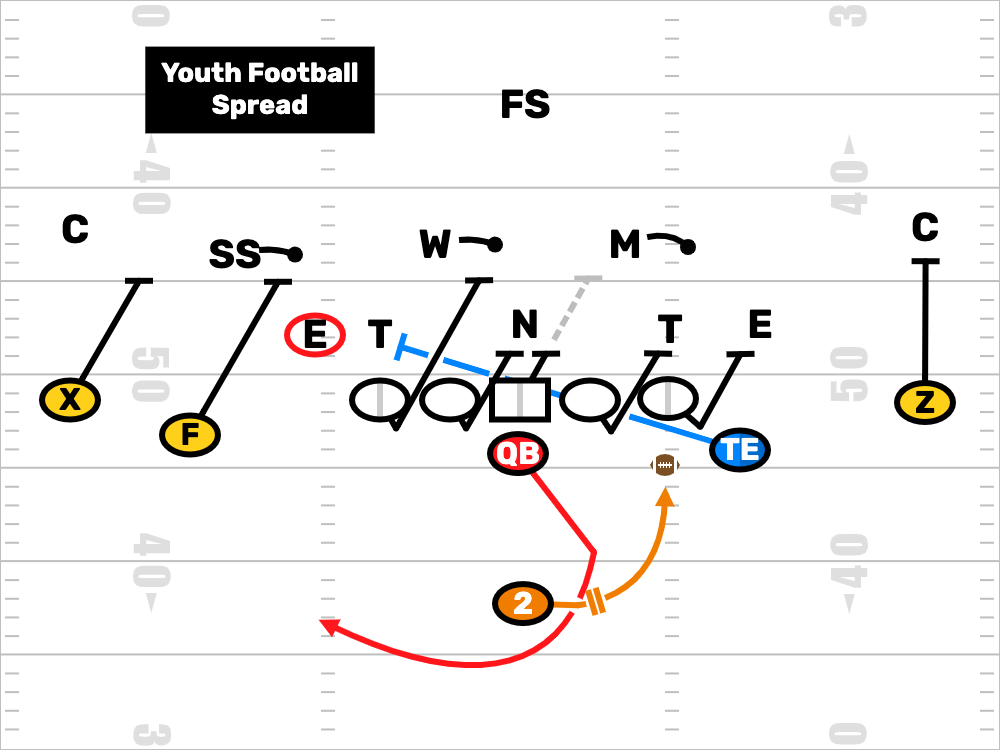
4. Spread Formation
The spread offense is the most popular offense in football right now. This is because the spread allows an offense to throw and run the football equally well. So if you are a youth football coach, the spread offense is a great option if your quarterback can throw the ball well. If your quarterback cannot, it will be a nightmare when you play a good defensive coordinator.
The FirstDown PlayBook youth football Spread formation tries to take all of this into consideration. Here’s why: When you start drawing up your run game with a short edge, there is normally at least one defender unaccounted for. This means that player is unblocked. If the play is a wide play to the other side, this can be overcome with a boot fake from your quarterback. If not, then you are playing with fire.
Do Not Choose Your Youth Football Offense While Watching Games On TV
You have to be honest with yourself and ask the hard questions. What are you going to do with your spread offense if the defense only marginally covers your receivers? It could happen if you play against a smart defensive coach. If your quarterback cannot take advantage of a defense overloading the box to stop the run, this is not the offense for you. Here’s why. You will now likely have two unblocked defenders at the point of attack even if you are running your quarterback.
So why do we even offer this offense to youth football coaches? Well, there are some 11 and 12-year-old quarterbacks who can force a defense to spread out. If you have this type of quarterback, the youth football spread formation is a great choice. The advantages will show up in the run game and the pass game.
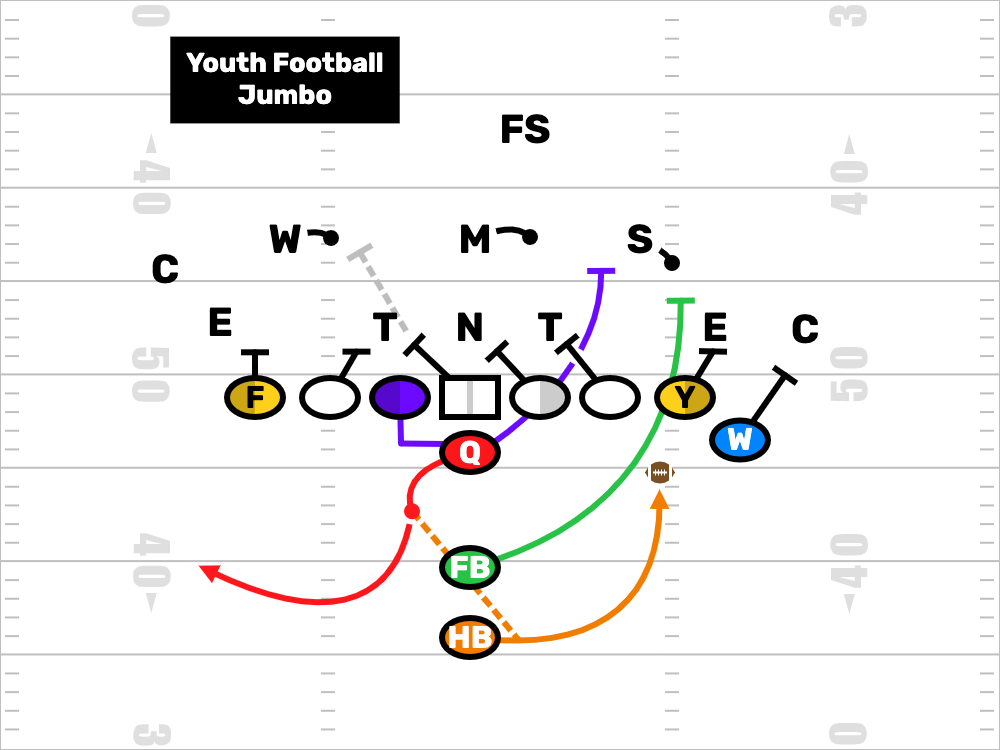
5. Jumbo Formation
A close relative to the Wing T formation that we looked at above is the FirstDown PlayBook Jumbo formation. With Jumbo, you still have the luxury of having a tight end and a wing, but now your backs are stacked. One of the negatives about the Wing T is that you don’t have a downhill lead offense. Jumbo gives you that downhill pop and the perimeter attack as well.
Jumbo is like any other kids’ football offense, in that it is going to be best for you if your personnel allows you to run it. In this case, a Fullback who can act almost as your third Guard is key. This is important because the fullback will create an extra gap inside. It is up to the defense to find where you are inserting your fullback.
Some defenses will overplay your wing side. When this happens, a good changeup is the downhill G lead as you see here. The linebackers will normally be over-aggressive as they try to stop the toss sweep. This play uses their fast flow against them and hits up inside with a guard and the fullback leading the way.
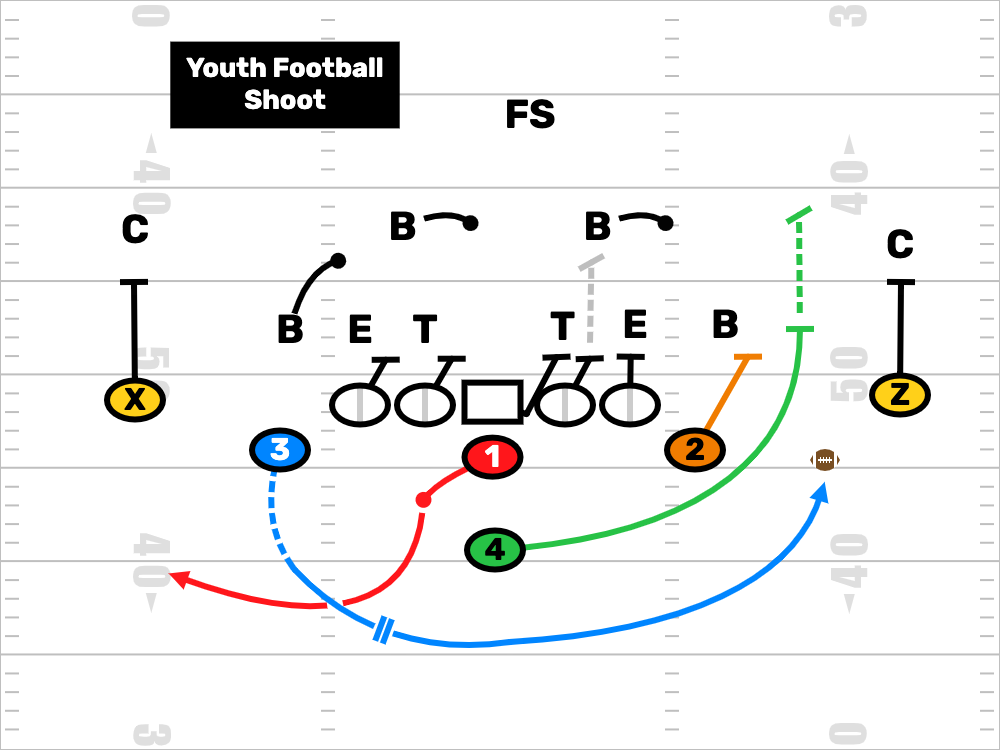
6. Shoot Formation
There are some immediate advantages to opening up your formation with the Shoot formation. The defense will typically have to loosen up a little with you. When they cover your widest receivers it can reduce the numbers inside. If you have a quarterback who can run the football, this can be a huge advantage for your offense. The youth football trap is a good play too.
The other advantage is that it gives you the ability to bring one of your slots in short orbit motion. This gives you an immediate two-back run game as well as an option game if your youth football quarterback can handle it. If you think about it, you get to a two-back formation in a split second and the defense doesn’t know the strength until the last second.
This Youth Football Formation Can Be Found In The FirstDown PlayBook FlexBone Area Too
However, when we talk about the Shoot formation, we always feel obligated to remind you that the defense does not have to spread out with you. It is important that you understand this before you spread your young players out across the field. The same thoughts that we mentioned with the youth football Spread offense should be in the front of your mind here.
You now have short edges on the backside of all of your runs and even your pass protections. The bigger issue is that if your quarterback cannot hurt the defense by throwing the ball outside, then the defense may start cheating their corners inside to stop the run. However, as long as the defense will spread out with you, this can be a powerful run offense at any level. FirstDown PlayBook offers more plays in our varsity section where we call it the FlexBone formation.
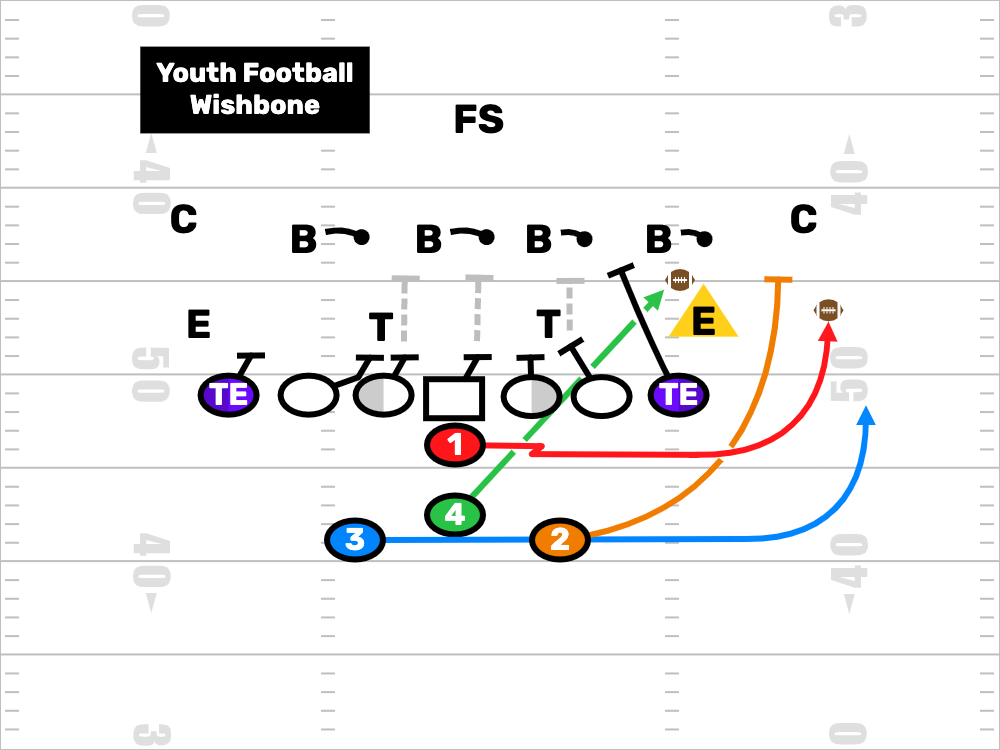
7. Wishbone Formation
The Wishbone formation has been synonymous with option football for a long time. The option is not a simple offense to run, but sometimes just the threat of it can be enough to have defenses on their heels. The great thing about having three backs in your youth football backfield is that you have a versatile running game, with or without the option.
With the Wishbone youth football formation, not only do you have three backs in the backfield, but you also have a perfectly balanced formation. Any time you have this, you force the defense to balance up as well. This means there is no cheating to one side or the other before the snap. You can literally run the exact same plays to both sides, once the ball is snapped.
This is why it is so hard to play defense against this formation. Defending option football forces the defense to play “assignment football”. If you have a dive back, a quarterback, and a pitch back, someone needs to be responsible for all three. Add in the fact that the option can be run to either side and it gets even harder. The defense does not even know their job until after the ball is snapped.
Can I Run The Option With My Youth Football Offense?
Is it hard or nearly impossible to coach your 10/11-year-olds to run an option offense? Yes, it is. That is why we recommend keeping your package small. Option style football drills should be a part of your practice as well. Your job as the coach is to make the defense account for all of the options. That does not mean that your players actually have those options. What looks like a dive option might actually be quarterback load or a predetermined fullback dive like you see in this drawing.
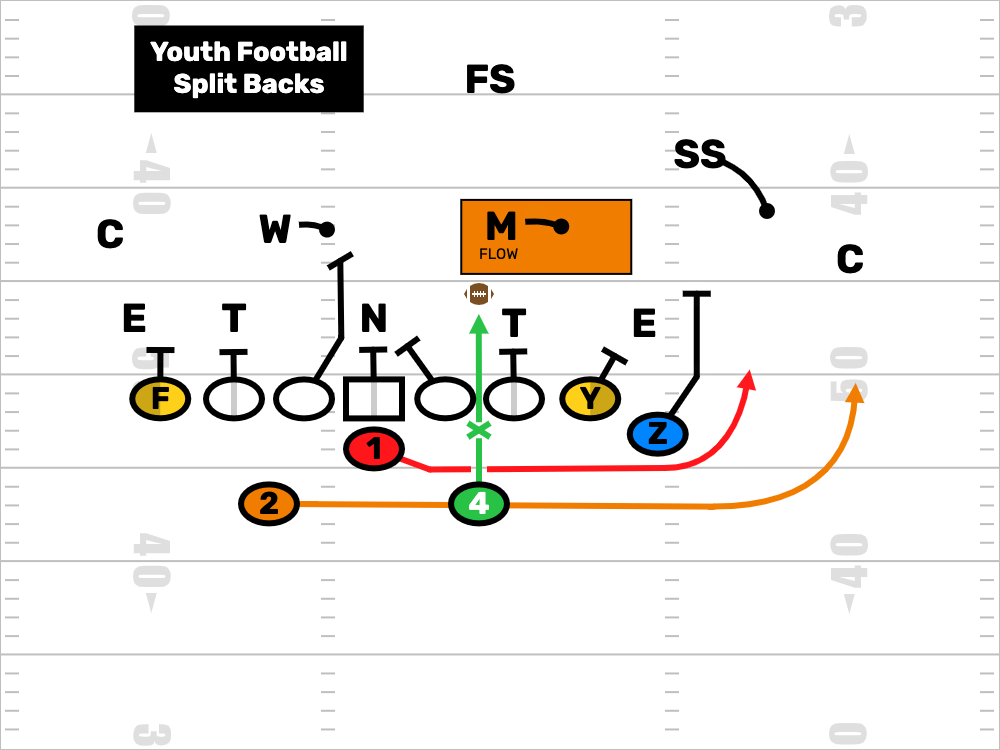
8. Split Backs Formation
The Split Backs formation is a tried and true youth football staple and for good reason. Once again, it is not unusual to have two talented running backs on a youth football team. It is also not unusual for both of them to be small and lack blocking skills. Well, if you can’t block them…deceive them.
The Split Backs formation gives you the ability to get out on the perimeter with either a sweep or an option attack. After all, this formation is where the Split Back Veer comes from. Once again, the option can be hard for young players, but keep this in mind. You can pre-determine what the quarterback does with the football with your call.
The play you see here looks like an option to the defense and it just might be. What is really called though is a 4 Back Dive. The quarterback and the 2 back are going to block several defenders with the fake. The next time you call this play you dictate the quarterback keeps it. The next time you can tell your quarterback to pitch it. It all looks the same to the defense.
The split backs formation is also a good way to feature your counter run game. The counter game could be with your two backs. It could also be with your quarterback. You can boot your quarterback away from a full-flow backfield to give you a nice easy bootleg pass to your tight ends.
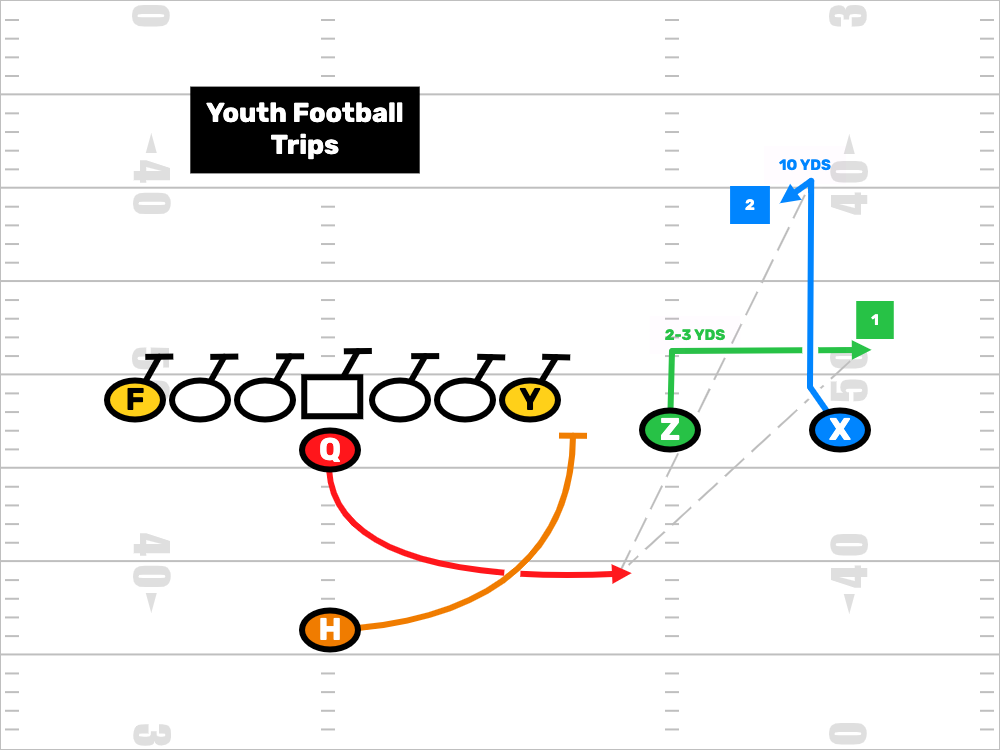
9. Trips Formation
The youth football Trips formation takes us into some new territory. Any time you line up with a formation where there are three more eligible receivers to one side than the other, you are forcing the defense to adjust. As long as you understand what you are doing this is a good thing.
The first thing to look for is how is the defense adjusting? Maybe they are not adjusting at all. If that is the case, let the numbers advantage be your guide. Attack the three-man strong side. If the defense moves an extra defender over or adjusts their alignment, then you need to have something for the weak side. This is not hard to do but important to remember.
One of the things we like most about the Trips formation is that it is an excellent way to throw the ball with a youth football quarterback. There are some excellent short to intermediate passes to the two receiver side that a young quarterback can make. We also suggest that you sprint or boot your quarterback out to the two receiver side to help them with the throw. Young quarterbacks will find it easier to throw when they are moving at their target.

10. Pro I Formation
The FirstDown PlayBook Pro I formation is a formation that everyone knows. This formation gives you a lead blocker for your tailback and it gives you two tight ends. The final big advantage is you have a wideout to one side allowing you to create two-man route concepts. There are different versions of this and you could flex out one or both of your tight ends.
With this, you have an inside run game and also a perimeter attack. As you can see from the sample play we have drawn up for this page, you should not be scared to hand it off to your fullback every now and then either. As you begin to choose your run plays for this formation be sure to add some plays with the fullback going one direction and your tailback heading the other. Linebackers love to key the fullback in this formation. You can break this key in a hurry by splitting your backs on the snap of the ball.
Here is what we really like about this formation at the youth football level: The Pro I is a perfect formation to begin teaching play-action passes to young players. When defenses see the fullback lead inside on runs enough, they begin to cheat. There are play-action pass answers to all of your receivers and even your fullback when the defense starts getting too aggressive.
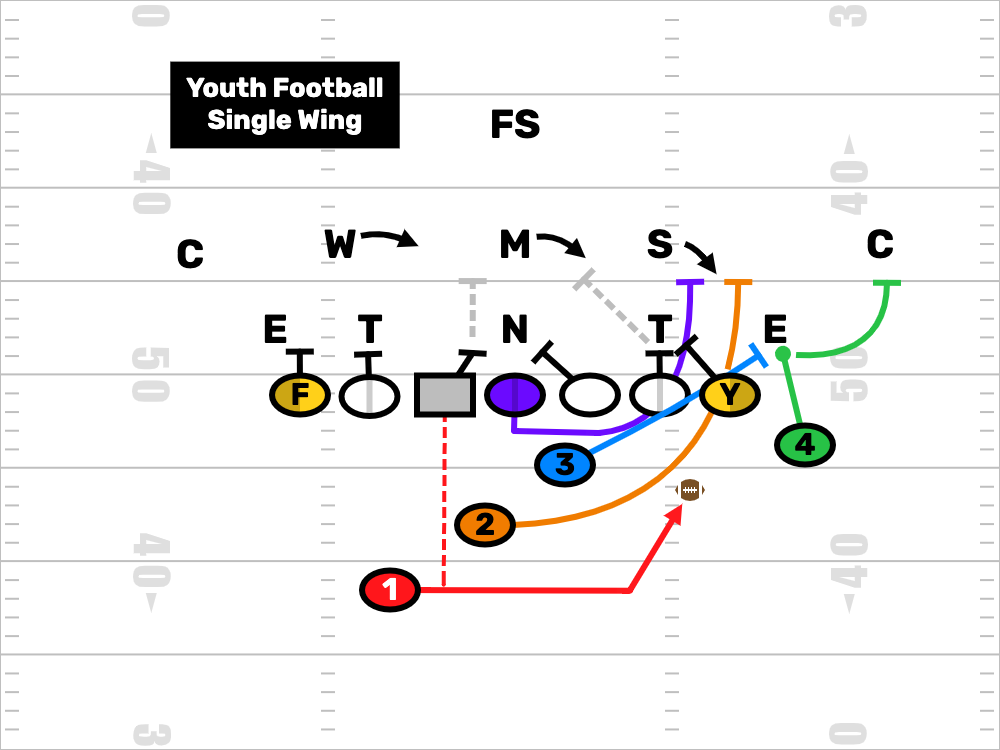
11. Single Wing Formation
It doesn’t get any more “throwback” than the Single Wing formation. You will find some who will smirk at this formation that has been around as long as football itself. However, they quit smirking when they are teaching their linebackers how to find the football after it is snapped.
The ability to have three viable ball carriers is one of the things that makes the Single Wing so effective. The really hard thing though is that the defense really has no idea who the ball will be snapped to. When this is taken away from a defense they have a very hard time finding the ball. Who do they key?
Many youth football defenses struggle with adjusting to a wing formation. A staple for the Single Wing is to line up in an unbalanced line as much as a standard one. We see a lot of plays drawn up vs defenses that don’t adjust to the unbalanced formation. This obviously gives the offense a pretty significant advantage. We don’t think you can count on this, but an unbalanced line with a Single Wing offense is good to have ready. You are looking at an example of this here.
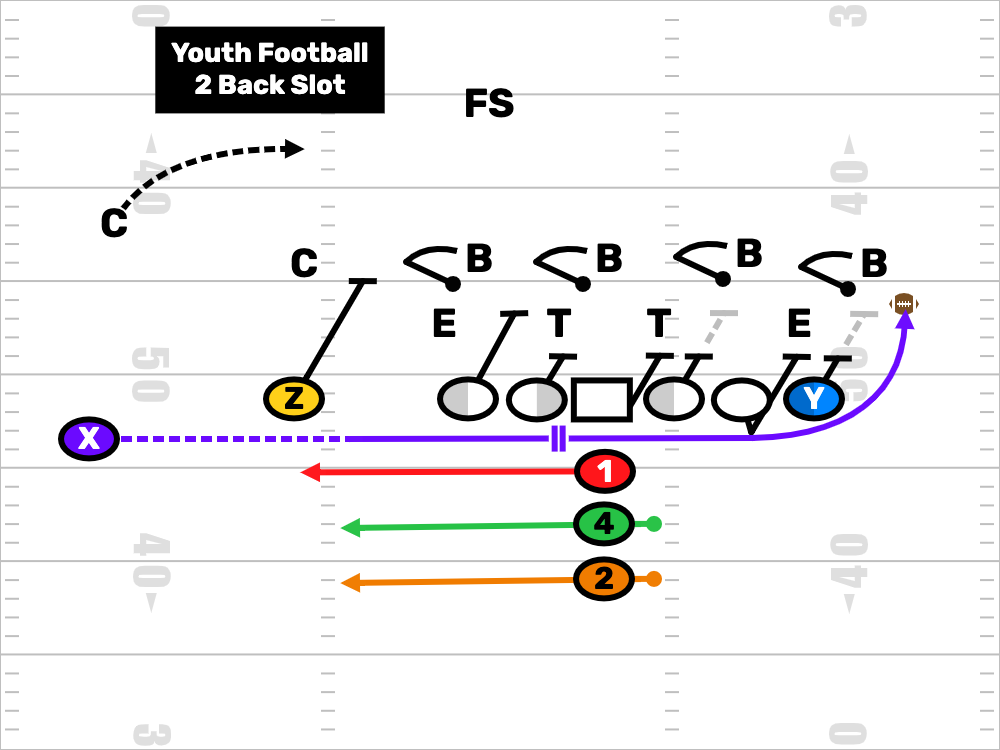
12. 2 Back Slot Formation
The FirstDown PlayBook 2 Back Slot formation can tell you a lot about the defense you are facing before the ball is even snapped. The 2 Back Slot formation is what we call a “revealing formation”. What that means is that it forces the defense to show what they are playing. Because there are two receivers on one side of the 2 Back Slot, the defense has some choices to make.
If they play both of their corners over on the two receiver side, that will tell you it is man coverage in youth football 100% of the time. If they let the corners stay on opposite sides of this formation, this probably still means it is man coverage but your blocking matchup to the weak side just got better. When you get this, you want to wear out the tight end side and make their corner tackle. It’s as simple as running at the smaller corner.
Finally, there are similarities in the 2 Back Slot formation and the Trips formation when it comes to the passing game. This formation gives you the ability to sprint and boot out to a two-receiver side. The difference is that you still have a 2 back running attack with 2 Back Slot. This means your play action pass game is also strong as it is with the youth football Pro I.
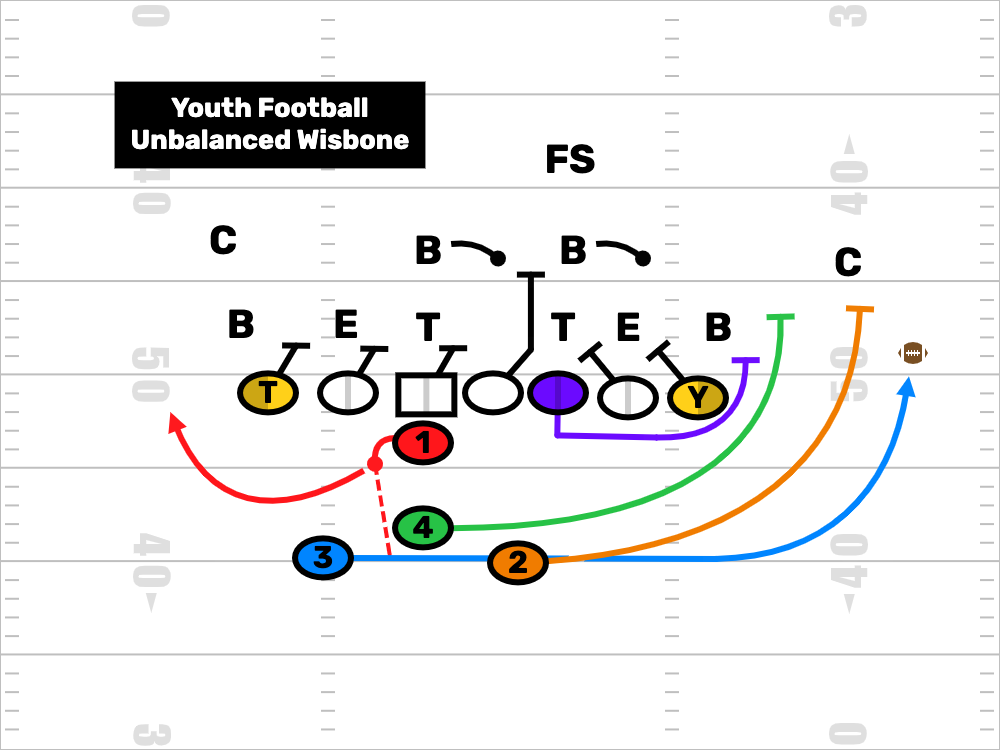
Bonus: Unbalanced Formations
Using unbalanced formations with youth football can be a very powerful tool. So powerful, in fact, that some youth programs don’t allow them. For those of you who can use them, this is for you. We define unbalanced as any formation that has four players on one side of the center and they are on the line of scrimmage. Conversely, there are only two on the line of scrimmage to the other side.
Immediately, you see that you have to know football rules to run unbalanced formations. The rules force the defense to adjust to your overloaded unbalanced formation. If the defense does not adjust, this can be a real advantage for your offense. There will be a leverage advantage for the offense. Even worse, there could be an eligible receiver who is not covered.
There is so much that we could write about when it comes to unbalanced formations. After all, we have unbalanced versions for all 12 of our youth football formations in FirstDown PlayBook. Just remember this though. Unbalanced formations can confuse a defense. When the defense is confused, they will often line up in a front or coverage that makes no sense. This can be hard to block and hard to coach against when it happens.
Always Remember That You Are Coaching & Raising Humans
Coaching the game of football at any level is a privilege. Our society looks at it with a degree of respect that can be hard to understand at times. The very best coaches always understand that it is not about them. It must always be about respect for the game and what is best for your players. As a youth football coach, your influence on your players is magnified because you are dealing with young impressionable minds.
Always try to put yourself in a situation where you run into one of your players 20 years down the road. What will they think of you? Were you the coach who made them hate playing football because they couldn’t down block well enough? Or were you the coach that coached them hard but also taught them about the benefits of hard work, practice and discipline? Trust us…they will remember you. It’s just a matter of how.
Our hats are off to you. Just like our educators today, you are making a real impact on our society by volunteering to coach a youth football team. The players you coach today will be our society tomorrow. Thank you.

